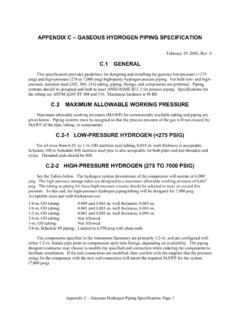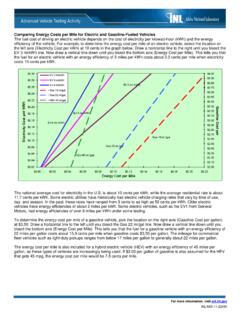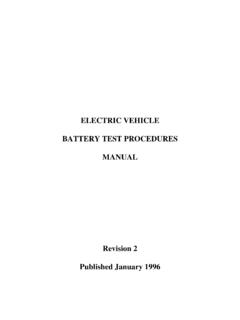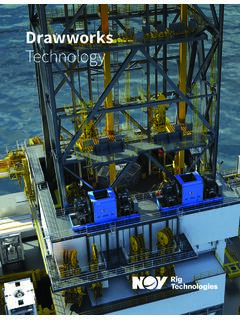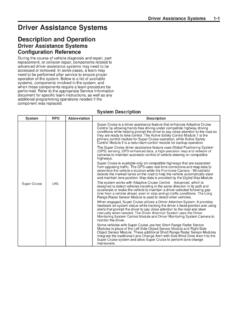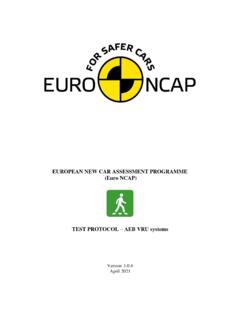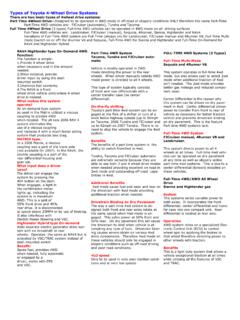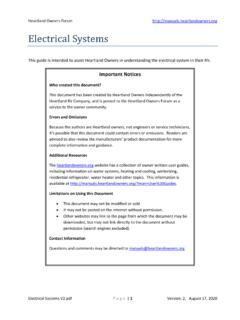Transcription of EV Power Systems (Motors and controllers)
1 For more information, visit EV Power Systems (Motors and controllers) The Power system of an electric vehicle consists of just two components: the motor that provides the Power and the controller that controls the application of this Power . In comparison, the Power system of gasoline-powered vehicles consists of a number of components, such as the engine, carburetor, oil pump, water pump, cooling system , starter, exhaust system , etc. Motors Electric motors convert electrical energy into mechanical energy. Two types of electric motors are used in electric vehicles to provide Power to the wheels: the direct current (DC) motor and the alternating current (AC) motor. DC electric motors have three main components: A set of coils (field) that creates the magnetic forces which provide torque A rotor or armature mounted on bearings that turns inside the field Commutating device that reverses the magnetic forces and makes the armature turn, thereby providing horsepower.
2 As in the DC motor, an AC motor also has a set of coils (field) and a rotor or armature, however, since there is a continuous current reversal, a commutating device is not needed. Both types of electric motors are used in electric vehicles and have advantages and disadvantages, as shown here. While the AC motor is less expensive and lighter weight, the DC motor has a simpler controller, making the DC motor/controller combination less expensive. The main disadvantage of the AC motor is the cost of the electronics package needed to convert (invert) the battery s direct current to alternating current for the motor. Past generations of electric vehicles used the DC motor/controller system because they operate off the battery current without complex electronics.
3 The DC motor/controller system is still used today on some electric vehicles to keep the cost down. However, with the advent of better and less expensive electronics, a large number of today s electric vehicles are using AC motor/controller Systems because of their improved motor efficiency and lighter weight. For more information, visit These AC motors resemble motors commonly used in home appliances and machine tools, and are relatively inexpensive and robust. These motors are very reliable, and since they have only one moving part, the shaft, they should last the life of the vehicle with little or no maintenance. Electric Motor Comparison AC Motor DC Motor Single speed transmission Multi-speed transmission Light weight Heavier for same Power Less expensive More expensive 95% efficiency at full load 85-95$ efficiency at full load More expensive controller Simple controller Motor/Controller/Inverter more expensive Motor/controller less expensive Controllers The electric vehicle controller is the electronics package that operates between the batteries and the motor to control the electric vehicle s speed and acceleration much like a carburetor does in a gasoline-powered vehicle.
4 The controller transforms the battery s direct current into alternating current (for AC motors only) and regulates the energy flow from the battery. Unlike the carburetor, the controller will also reverse the motor rotation (so the vehicle can go in reverse), and convert the motor to a generator (so that the kinetic energy of motion can be used to recharge the battery when the brake is applied). In the early electric vehicles with DC motors, a simple variable-resistor-type controller controlled the acceleration and speed of the vehicle. With this type of controller, full current and Power was drawn from the battery all of the time. At slow speeds, when full Power was not needed, a high resistance was used to reduce the current to the motor.
5 With this type of system , a large percentage of the energy from the battery was wasted as an energy loss in the resistor. The only time that all of the available Power was used was at high speeds. Modern controllers adjust speed and acceleration by an electronic process called pulse width modulation. Switching devices For more information, visit such as silicone-controlled rectifiers rapidly interrupt (turn on and turn off) the electricity flow to the motor. High Power (high speed and/or acceleration) is achieved when the intervals (when the current is turned off) are short. Low Power (low speed and/or acceleration) occurs when the intervals are longer. The controllers on most vehicles also have a system for regenerative braking .
6 Regenerative braking is a process by which the motor is used as a generator to recharge the batteries when the vehicle is slowing down. During regenerative braking , some of the kinetic energy normally absorbed by the brakes and turned into heat is converted to electricity by the motor/controller and is used to re-charge the batteries. Regenerative braking not only increases the range of an electric vehicle by 5 - 10%, it also decreases brake wear and reduces maintenance cost.
